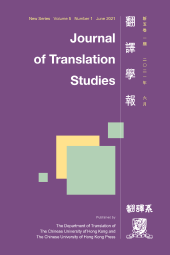 |
|
||||||||||||||||||||||||||||||||||||||||||||||||||||||||||||||||||||||||||||||
| Literary Barters: A Network Science Approach to Agency in Translation |
|---|
| Raluca Tanasescu University of Groningen |
|
Abstract This essay proposes complexity and computational network analysis as fitting paradigm and methodology for studying contemporary literary translators’ agency. Grounded in the rhizomatic structure of networks, this approach unearths the importance of translation-based literary barters for the robustness and stability of a translation sub-system, in our case the sub-system of contemporary poetry translation from American and Canadian English into Romanian. Using a mixed-method approach that combines close reading (qualitative analysis) and distant reading (quantitative analysis), the research shows that translators possess an essentially connective mind and that their own interests and network of personal connections are salient in starting and maintaining a substantial exchange of inter-cultural transfers in a transnational context. Complexity thinking provides the premises for demonstrating that translation is highly sensitive to its initial conditions of production, thus is reliant on translators, and the computational network analyses prove consequential for documenting the role of translators in initiating and carrying out literary translation projects. |
| From Arden to Vrindavan: As You Like It, YouTube Bazaar Notes, and the Creative Remediation of a “Waterloo” Text |
|---|
| Sonali Barua Azim Premji University |
|
Abstract The YouTube Shakespeare phenomenon has been addressed in several studies including those by Christy Desmet (2009, 2014) and Stephen O’Neill (2014, 2015). This paper builds on their work to examine closely the visual, aesthetic and aural strategies of a YouTube video that seeks to make Shakespeare’s As You Like It more accessible to a group of Bengali-speaking students in small town West Bengal, India. The paper examines (a) the means by which the video creator works to activate prior knowledge in his target viewers, (b) the consequent degree of cognitive success he appears to have achieved in terms of summary and explanation, and (c) this video not just as a teaching tool, but as a piece of creative remediation in its own right, and an original contribution to YouTube Shakespeare. The easy access to the visual dimensions of the global popular afforded by immersion in a digital environment both necessitates and enables more flexible and innovative approaches to bringing alive the sometimes archaic language in canonical literary texts, in this case, Shakespeare’s plays. The paper demonstrates how the video allows the creator to harness the capabilities of one of YouTube’s key pedagogical affordances: the digital image, in conjunction with the site’s potent play and gaming possibilities, as well as the sense of community in shared space that it fosters in regular users. The creator’s deployment of images is apparently idiosyncratic; but these images are culled from a wide variety of online loci that are particularly relevant, comprehensible, and attractive to the demographic he addresses. This strategy enables him to use the exciting possibilities of play, exploration, and cross-cultural connection to engage students effectively in a text recognized as challenging in the Indian context. A related broader argument made here pertains to the role of such digital videos in the shaping of the Global Shakespeare that scholars such as Alexa Huang have highlighted in the last decade. Teaching/explainer videos like the one analyzed in detail here, which combine the exoticism and excitement of globally sourced digital images and the youthful power of play with specific local references and an accessible vernacular voiceover can make a crucial contribution towards reshaping a new generation of glocal non-Anglophone iterations of Shakespeare. |
| Translation as a Donor in Constructing Cross-Linguistic Epistemologies in Text Computing |
|---|
| Gabriele Salciute Civiliene King’s College London |
|
Abstract While in-between knowledge has proved to be vital for the growth of translation studies, the actual and potential influence of translation theory on other disciplines has received little attention. Its contribution to digital humanities, for example, has been considered mostly in relation to the use of translation as a tool to disseminate knowledge at research events. Although in recent years digital humanities has shown increased interest in languages and linguistic diversity, its techno-linguistic foundations remain limited to English. Translation supplies digital humanities with an interesting epistemo-methodological problem that challenges monocultural epistemologies in text computing. While distant reading in one language is relatively straightforward, computation across languages faces many challenges, including Anglophone bias, economies of scale, blackboxes, and lack of phenomenological depth. If we can solve these problems, disrupting monolingual practices in knowledge production would be one of many benefits of cross-linguistic computation. In this paper, I will discuss the affordances of translation by drawing on my ongoing research, including the DRaL (Distant Reading across Languages) project which began with the concerns of how to make digital research epistemologies more inclusive of and more open to languages other than English. |
| Literary Translation as a Touchstone of the Exchanges between Western and Chinese Medical Culture: A Case Study on Qi Wang Hui (1906) |
|---|
| Zhen Yuan City University of Hong Kong Bo Li City University of Hong Kong |
|
Abstract In early twentieth-century Hong Kong, the rendition of medical terminology in the translated detective stories of Chinese-language periodicals reflected translation as a touchstone of the early exchanges between Western and Chinese medical culture. Among them, the literary translation Qi Wang Hui (1906) is a case in point. In the Chinese version, the Western terms for medical instruments, drugs and diseases, among others, were inconsistently translated. Some of the terms were translated literally, with the original meaning largely preserved, whereas some others were translated using words from Traditional Chinese Medicine. Others were translated as Chinese referents of more general concepts. The different strategies for dealing with the translation of various terms reflected the unbalanced recognition of Western medical knowledge and technology in the Chinese cultural context. |



